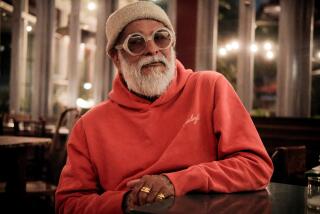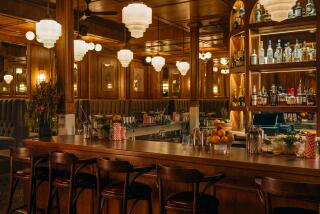An encore for the historic Dunbar Hotel
Back in the days of the jazz greats, when most of the downtown L.A. hotels were still segregated, the Dunbar Hotel was the place that rolled out the carpet for visiting African American musicians and the fans who flocked to see them.
London Carter was among those who soaked up the lore of the South Central Avenue hotel, where Cab Calloway, Billie Holiday and Louis Armstrong once were guests and often played. But the Dunbar fell into decline and finally closed as a hotel in the mid-’70s.
But now Carter’s back, a resident of room 503 in the Dunbar’s second life as a senior-living facility. From his balcony, the old hotel’s neon light has come back to life. And next month, when the weather turns warmer, he’ll be able to listen to a jazz festival on the street below by doing nothing more than opening his windows.
Carter, a retired surgical technician, learned of the old hotel’s rebirth from a flier announcing that the Dunbar was being resurrected for senior housing.
At 59, Carter certainly met the 55-and-older requirement for those interested in renting the new studio and one-bedroom units carved out of the space originally taken by the hotel’s 115 rooms. But it was the Dunbar’s history as the onetime centerpiece of the city’s jazz scene and the go-to place for visiting African Americans that hooked him.
“I was born in South-Central L.A. in 1954. Back then Watts had the Watts Towers, Hollywood had the Chinese Theatre, and we had the Dunbar Hotel,” Carter said.
“Back in the day, Central Avenue was like Rodeo Drive for blacks,” he said. “It was a very proud place.”
When Carter finally visited the Dunbar to look into applying for one of the 41 apartments, he told representatives of the hotel’s developers the history of the place, how Ella Fitzgerald, Duke Ellington, Lena Horne, Armstrong and others had stayed there.
A jazz lover, Carter told them that for years he has returned to the hotel each July for the annual festival held on the street in front of the Dunbar.
“People like Poncho Sanchez and Sheila E. play at those. I told them it would be a dream to say I live at the historic Dunbar Hotel.”
Impressed, project representatives offered Carter apartment 503 — where the living room windows open up to a view of the Dunbar’s iconic neon sign.
He has now moved into the apartment, which he refers to as “the penthouse,” guranteeing himself a choice seat for the 18th annual Central Avenue Jazz Festival next month. Rent for his one-bedroom unit with brand-new kitchen appliances is $746 a month, according to Carter, who lives on Social Security and his Army disability pay.
The Dunbar, which opened in 1928, was designated as a city Historic-Cultural Landmark in 1974 and placed on the National Register of Historic Places two years later. That means its original architecture and Art Deco motif have been carefully preserved during the renovation, which is a partnership involving Thomas Safran & Associates, the nonprofit Coalition for Responsible Community Development and the city’s Housing Authority and Community Redevelopment Agency. Andrew Gross, president of development for the Safran firm, praised City Councilwoman Jan Perry for helping coordinate the redevelopment.
On a recent afternoon, workers were rebuilding a fountain in the center of a flagstone patio that fills an atrium between the hotel lobby and its original jazz nightclub. In the lobby, artists Joe Nicoletti, Bali James and Jo Bainbridge Cobbett were crouched on scaffolding as they restored three original murals that towered over the hotel’s front desk when it was built in 1928. Fittingly, music by Lionel Hampton was playing on a boom box in the background.
Nicoletti said he was surprised to find that the murals depicted Southwestern themes and not the Jazz Age.
“The murals were dark. One of them was partly painted over. There were decades of smoke and tobacco on all three of them,” he said. That’s because the hotel lobby was where business deals were done and community leaders and intellectuals met nightly to discuss politics and African American affairs.
The front desk has been replaced by a mailbox alcove for residents. The renovators are now seeking a tenant interested in opening a “speakeasy”-type club or restaurant in the hotel’s former nightclub, Nicoletti said.
The $30-million renovation, dubbed Dunbar Village, includes another 42 apartments in two neighboring buildings that have also been refurbished for low-income family housing. They are named the Somerville Apartments in honor of John Somerville, who was USC’s first black graduate and the original builder of the Dunbar Hotel. When Somerville lost the property after the 1929 stock market crash, the hotel was renamed by new owners in recognition of African American poet Paul Laurence Dunbar.
A succession of owners operated the hotel in subsequent years. The Dunbar fell into decline after other Los Angeles hotels began registering black guests and closed its doors in 1974. It reopened in 1990 as low-income housing, although the city foreclosed on the property in 2008 when its owners fell behind in repaying publicly funded loans.
Leaders of the renovation project said a formal reopening of the Dunbar is scheduled June 26, although new tenants chosen through a lottery are already moving in.
Seventy-one-year-old retired nurse Sarah Hawkins is settling into her second-floor apartment and she too remembers the Dunbar as being ground zero of the West Coast jazz scene. In its heyday there were several other jazz clubs that thrived within steps of her new home.
“Movie stars would come down here from Hollywood and Sunset boulevards to go to the clubs,” she said. “It was a wonderful time.”
More to Read
Sign up for Essential California
The most important California stories and recommendations in your inbox every morning.
You may occasionally receive promotional content from the Los Angeles Times.











